Rimfires in the field
by John Robinson
Hunter 6
 The .22 rimfire has put more lead in the air than any other calibre used for hunting, yet it is a cartridge that is more limited in its applications in the field than almost any other.
The .22 rimfire has put more lead in the air than any other calibre used for hunting, yet it is a cartridge that is more limited in its applications in the field than almost any other.
Consider the basic ballistics: the .22 Long Rifle cartridge launches a 40gn bullet at about 1300fps (393m/sec) in its high velocity manifestation. At the muzzle, which is a range at which little game is shot, this load has a muzzle energy of only 150ft/lb. At 100m, the bullet has slowed to 1000fps (303m/sec) and the energy has fallen to 90ft/lb.
Throughout the years, many ammunition manufacturers have attempted to challenge Newton’s Laws for the Conservation of Energy by developing .22 rimfire loads using lighter bullets (eg, 29gn) at higher velocity. By increasing velocity, kinetic energy is increased by the square of the velocity. In other words, doubling the velocity will quadruple kinetic energy. More about this later.
A more realistic development came with the introduction of the Winchester .22 Rimfire Magnum in the 1960s, although this cartridge has never achieved the popularity in the field as its performance deserves.
In the 21st Century, a .17 calibre rimfire, based on the .22 magnum case, has been introduced by Hornady as the first really ‘new’ rimfire cartridge in almost 50 years, as claimed by the manufacturers.
Fact is that Arthur Langsford, intrepid Broken Hill-based inventor of novel and useful cartridges, had his own .17 Rimfire Magnum about 15 years ago that he developed for fox shooters.
The new Hornady .17 HMR shoots a 17gn bullet at 2550fps (772m/sec) and I am sure, like the .17 Remington, it will perform beyond its tiny size on small game. The greatest drawback to a cartridge like this gaining popularity, like the 5mm (.20 calibre) Remington Rimfire, which is long discontinued, is the cost and availability of ammunition. At more than $50/100, it is unlikely to outsell .22 LR ammo that can be bought in bulk for about 15 per cent of that price or .22 Magnum ammo that is less than half the cost.
In spite of its limitations, the .22 Rimfire remains a very popular field cartridge and few keen hunters would be without a rimfire rifle in their gun rack.
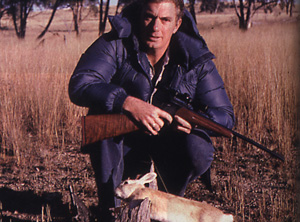
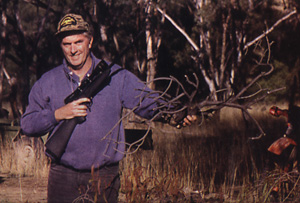 While rabbit numbers are much reduced these days, there are few more pleasant hunting experiences than wandering through bunny country on a sunny afternoon anticipating a shot at a rabbit or two. There is no better way to introduce the younger members of the family to hunting and sports afield than with ammo that has hardly any recoil or muzzle blast.
While rabbit numbers are much reduced these days, there are few more pleasant hunting experiences than wandering through bunny country on a sunny afternoon anticipating a shot at a rabbit or two. There is no better way to introduce the younger members of the family to hunting and sports afield than with ammo that has hardly any recoil or muzzle blast.
No other cartridge has been subjected to the degree of specialisation that the .22 rimfire has enjoyed. The range of variations within even individual brands is enormous. There are a large number of options in the target ammunition range, with ammo designed for specific matches.
Eley, Winchester, Federal, RWS, CCI, S&K, Remington, Fiocchi, Lapua and others each produce various special types of match ammunition. This builds on one of the great features of the .22 rimfire, particularly the .22 LR: its inherent accuracy.
Very few .22 rimfire rifle/ammo combinations do not shoot acceptably and it is also an easy combination to shoot well.
Most .22 rimfire loads designed for target shooting are sub-sonic. This means that they have a muzzle velocity of less than 1100fps (333m/sec). There is a reason for this and that is that .22 bullets travelling at less than the speed of sound are less affected by wind drift that those travelling supersonically. A fringe benefit is that the loads are quieter, as the bullet does not pass through the sound barrier.
While giving away some energy, sub-sonic loads are still very useful in the field because of their accuracy and low noise level. For spotlighting, sub-sonic loads are ideal. In days gone by, I have spent some time spotlighting on foot using a .22 rimfire and a spotlight powered from a motorbike battery.
Most shots are taken at less than 25 metres and the great advantage of this form of hunting is the low noise level created by walking quietly instead of driving around in a vehicle with the headlights on.
The noise level from a .22 bolt action rifle with a 600mm barrel is very low with this type of ammo and the rabbits are more startled by the sound of the bullet hitting the dirt than by the sound of the rifle.
While rarely used by Australian shooters, a very low velocity load based on the .22 Long with its 29gn bullet is popular with European shooters for indoor target shooting. This cartridge, usually identified with a ‘Z’ prefix, shoots its 29gn bullet at only about 200m/second.
When fired from a bolt action rimfire, a Z22 makes about as much noise as an air rifle and is ideal for dispatching small varmints close to civilisation, as long as it is legal to shoot a firearm in the area. It is a great ‘barn’ load and is quite capable of dealing with the likes of feral cats at close range with well-placed shots.
There are some intermediate .22 LR specialist target loads that work well in the field. The advent of rimfire silhouette competition has seen a number of ammo makers producing target grade loads that travel out of the barrel at higher velocities and some have heavier bullets, weighing 42 grains.
These are designed to knock down the steel targets more reliably while delivering the accuracy and flatter trajectory required in the match, where some targets are shot at 90 metres. The energy of these heavier bullet loads is about eight per cent higher than regular high velocity LR loads at 90 metres.
The next level up are the standard high velocity loads. The top speed of these loads varies from brand to brand, but all can be considered to average about 400m/sec.
Some of the well-known brands of high velocity rimfire ammunition are exceptionally accurate also and Winchester’s PowerPoint has established a very good reputation in this respect, to the point where many silhouette shooters shooting handgun silhouette use this load for preference. RWS HV ammo is also excellent in this respect in my experience.
The so-called hyper-velocity rimfires have never caught on, although the ammo makers tried hard enough. Winchester’s Expediter, Remington’s Viper and similar loads use lighter bullet loads, typically 29 grains, with bigger powder charges. Some use slightly longer cases to accommodate the powder.
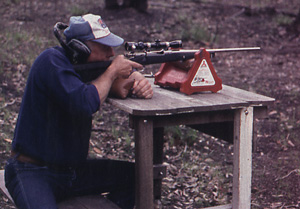
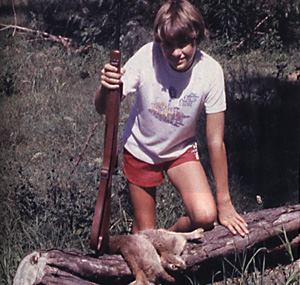
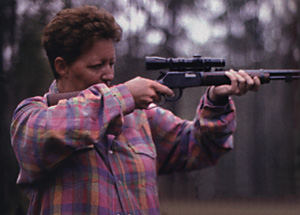 While these loads look good on paper, their exterior ballistics don’t shape all that well. The light bullet loses velocity quickly and by the time the bullet has travelled 100 metres, the remaining energy is little different to an HV LR. For example, a 30gn ‘hyper vel’ load with a muzzle velocity of 1650fps (500m/sec) and a muzzle energy of 200ft/lb has exactly the same energy remaining at 100m as a 40gn HV load with only 25mm difference in mid-range trajectory over that distance.
While these loads look good on paper, their exterior ballistics don’t shape all that well. The light bullet loses velocity quickly and by the time the bullet has travelled 100 metres, the remaining energy is little different to an HV LR. For example, a 30gn ‘hyper vel’ load with a muzzle velocity of 1650fps (500m/sec) and a muzzle energy of 200ft/lb has exactly the same energy remaining at 100m as a 40gn HV load with only 25mm difference in mid-range trajectory over that distance.
The main troubles I have experienced with hyper-velocity .22 rimfire ammo is that it rarely shoots to the same point of impact as does .22 LR HV loads, nor does it deliver equivalent accuracy.
The .22 Magnum is definitely a cut above the rest as a field cartridge. The standard .22 Magnum loads shoot a 40gn bullet at about 600m/sec. While this does not look that much more than .22 HV LR, it rates more than twice as good in my experience.
While the .22 LR is okay for game up to the size of rabbits, it is a marginal cartridge for foxes, although plenty have been shot with it. The .22 Magnum has comfortably double the effective range of the .22 LR and is an ideal cartridge on larger small game within its range limitations.
While .22 Magnum ammunition is considerably more expensive than .22 LR ammo, it is my choice as an all-round rimfire hunting cartridge. While lacking the vast variety of the .22 LR, the .22 Magnum still offers a range of load options, including plated and copper jacketed soft point and hollow point projectiles.
Federal offers its Classic .22 Magnum loads with a 50gn bullet loaded to about 500m/sec. I have found this a very accurate load and, while travelling slower than the standard loads, it is a reliable performer on ‘larger’ small game. This load has about 180ft/lb of energy remaining at 90m compared to 155ft/lbs for a standard 40gn load.
Winchester also offers a higher velocity ‘Varmint’ load in .22 Magnum loaded with 34gn jacketed hollow point bullets.
One of the greatest tragedies for hunters following Port Arthur was the prohibition on .22 selfloaders. A .22 selfloader was one of the greatest small game hunting tools and I still mourn the loss of my Ruger 10-22.
We have to learn to live with the consequences of other people’s action and that has limited the options now available. Nowadays, we can legally use bolt actions, pump actions, lever actions or single shots. Few would elect to use the last on the list and few gun makers produce pump action .22 Rimfires that are readily available here and, for some reason, pump guns have never been all that popular with Aussie hunters.
There are many bolt action rimfires available, in both .22 LR and .22 Magnum. The one I use is Ruger’s 77-22, mainly because of its great ten-shot rotary magazine, which has the capacity and does not stick out of the gun as do most ten-shot magazines. I have other .22 bolt action rifles that are more accurate and have better trigger systems, but the Ruger always accompanies me into the field.
There is a variety of bolt action rimfire rifles covering all price categories, from economy models for a few hundred dollars up to those with price tags well over $1000. Some like Brno have almost legendary status with Australian shooters and the Model 2, and its various manifestations, remain among the most popular hunter’s rimfires based on their robust design and consistent accuracy.
There are some very good lever action rimfires available. Winchester’s 9422 is a well made and very accurate outfit, as is Ruger’s lever action Model 96, which is almost identical in configuration to the great 10-22. Marlin and Browning also produce lever actions, which have established good reputations, and most come in Magnum or Long Rifle chamberings.
Of these types of actions, the better quality bolt actions usually offer better (adjustable) trigger systems and some, like the Anschutz 1422, have target rifle barrel and chamber specifications and deliver amazing accuracy (12mm groups at 50m) for a sporting rifle.
Finally, when hunting with a .22 Rimfire, be it a Long Rifle or a Magnum, treat it as you would a centrefire rifle with respect to loads. Sight the rifle in with whatever loads you prefer and stick with it. There can be a significant difference in point of impact from brand to brand or even within brands.
High velocity ammunition may not always shoot apparently flatter than slower loads because of these changes in point of impact. Just last weekend I undertook a test with a variety of .22 ammo, ranging from Eley Tenex to RWS High Velocity, from the same rifle at 50m. Group centres were as much as 50mm different from one ammo type to another and the Eley Tenex target ammo shot higher than the RWS High velocity in this particular rifle - a Unique T Series Silhouette rifle.
This point of impact variation is enough to miss a rabbit at that range so select your preferred brand and stock up on it.
Captions
Image 1: The Ruger M96 is a lever action variant of the great (and now illegal) 10-22. It is available in both .22 Magnum and .22 LR and utilises the rotary magazine common to other Ruger rimfires.
Image 2: The single shot Contender carbine is a great ‘camp gun’. It is very light and compact and its external hammer makes it ideal for young shooters.
Image 3: Only with a .22 can you have this sort of fun. Author’s Contender Carbine with .22 Match barrel was used to shoot these large mistletoe plants off a camp shade tree, which was being killed by the big parasitic plants. What a trophy!
Image 4: Any .22 Rimfire should be sighted in with the particular brand of ammo that is going to be used in the field. Variation in point of impact can occur with different varieties of rimfire ammo.
Image 5: Young hunter with a .22 Brno Model 2 with a haul of rabbits.
Image 6: Winchester’s 9422 lever action is a high quality rimfire built to handle both Long Rifle and .22 Magnum chamberings. The tubular magazine gives it good capacity and its short overall length enhances its handling.
